If you’ve just stepped into the world of self-publishing through Kindle Direct Publishing (KDP), you’ve probably heard about Amazon Ads or KDP Ads. These ads can be one of the most powerful tools to boost your book sales, get more readers, and make your book visible among millions of titles on Amazon.
But let’s be honest — when you’re new, the whole idea of running ads can feel confusing. You might be wondering, What exactly are KDP ads? How do they work? Are they expensive? Don’t worry — this guide will break it all down for you in simple language.
What Are KDP Ads?
KDP Ads, also called Amazon Advertising, are paid promotions that help your book appear in more visible spots on Amazon. When readers search for something like romance novel or self-help books, your ad can appear on top of the search results or within similar book pages.
Basically, you’re paying Amazon to show your book to people who are likely to buy it.
Think of it like this: if your book was sitting on a shelf in a huge bookstore, KDP Ads help move your book right up to the front display — where everyone can see it.
Why KDP Ads Are Important
Amazon is crowded. Every day, thousands of new books are published. Even if you have a great story, people won’t find it unless it’s visible. That’s where ads come in.
Here are a few quick reasons why KDP Ads matter so much:
✅ Visibility – Your book appears in front of people who are actually searching for something similar.
✅ Targeted Reach – You can show your book to the exact audience (like thriller fans, cookbook lovers, or sci-fi readers).
✅ Sales Growth – When more people see your book, you naturally get more clicks and, hopefully, more sales.
✅ Keyword Learning – Ads teach you which search terms people use to find books like yours.
✅ Author Branding – Even if people don’t buy right away, your name starts to appear everywhere.
How Do KDP Ads Work?
Let’s keep it simple. KDP Ads work on a Pay-Per-Click (PPC) model. This means you only pay when someone actually clicks on your ad — not just when they see it.
So if your ad shows up 1,000 times but only 10 people click, you’ll pay for those 10 clicks.
Here’s how it works step by step:
-
You create an ad campaign for your book.
-
You select keywords or categories related to your book.
-
You set a daily budget and a bid amount (how much you’re willing to pay per click).
-
Amazon shows your ad when people search for related books.
-
When someone clicks, you pay a small fee (usually between $0.20–$0.70 per click).
If your ad performs well, you’ll start seeing sales and impressions grow over time.
Types of KDP Ads
Amazon offers a few types of ad campaigns for authors. The main ones are:
| Type of Ad | Where It Appears | Best For |
|---|---|---|
| Sponsored Products | Search results and product pages | Single books (most popular option) |
| Sponsored Brands | Banner ads with multiple books or author name | Authors with more than one book |
| Locksreen Ads (for Kindle) | On Kindle devices and apps | Ebooks in specific genres (romance, thrillers, etc.) |
If you’re just starting out, go with Sponsored Product Ads. They’re simple to set up and give you direct data about what’s working.
Setting Up Your First KDP Ad
Let’s go step by step — no confusing jargon.
-
Log in to your KDP Account.
Go to the “Marketing” tab and click “Create an ad campaign.” -
Choose your marketplace.
For example, choose Amazon.com (US) if most of your readers are in the United States. -
Pick the type of ad.
Start with “Sponsored Products.” -
Select your book.
Choose one of your published books from the list. -
Choose targeting.
You can target keywords (like “mystery novels”) or categories (like “cozy mystery”). -
Set your bid and budget.
You might start small — like $5 a day with a bid of $0.30–$0.50 per click. -
Write your ad copy (optional).
Some ads don’t need text, but if they do, keep it short and engaging. -
Launch the campaign.
That’s it! Once Amazon reviews it, your ad will start running.
Keyword Targeting Tips
Keywords are the heart of your campaign. Picking the right ones can make or break your ad.
Here’s how to find great keywords:
-
Look at similar books in your genre. What words appear in their titles or descriptions?
-
Use free tools like Publisher Rocket or Google Keyword Planner.
-
Think like a reader — what would you type if you were looking for a book like yours?
Try to mix broad keywords (like “fantasy novels”) with specific ones (like “epic dragon fantasy adventure”).
How Much Do KDP Ads Cost?
The great thing is, you control the budget. You can start as low as $2–$5 per day.
Here’s an example:
| Daily Budget | Average Clicks | Average Sales Potential |
|---|---|---|
| $5 | 10–20 | 1–3 books per day |
| $10 | 30–40 | 3–5 books per day |
| $20 | 50–70 | 6–10 books per day |
Of course, results vary by genre, cover quality, and reviews.
Don’t worry if your ads don’t make profit instantly. It takes time for Amazon’s algorithm to learn which readers are responding best to your book.
Understanding Reports
Once your ad is live, you can check its performance.
You’ll see metrics like:
-
Impressions: How many times your ad was shown
-
Clicks: How many times people clicked your ad
-
CTR (Click-Through Rate): Clicks divided by impressions
-
ACOS (Advertising Cost of Sales): How much you spent vs how much you earned
If your ACOS is below 70%, that’s generally good. It means your ad is making more money than it’s spending.

Common Mistakes Beginners Make
-
Using Too Many Keywords – Start with 30–50 good ones, not hundreds.
-
Setting Bids Too High – Don’t overpay just to show up first.
-
Stopping Too Early – Ads need at least 2–3 weeks to show proper results.
-
Ignoring Book Quality – Even great ads can’t sell poor covers or weak blurbs.
-
Not Testing – Try multiple ad versions to see what performs better.
Pro Tips for Better Results
⭐ Update Your Book Description – Make it short, emotional, and engaging.
⭐ Use Eye-Catching Covers – Your ad is only as good as your cover.
⭐ Test Automatic Campaigns – Let Amazon choose keywords for you in one campaign, then use a manual campaign with what works.
⭐ Track ACOS Weekly – Don’t make changes daily; give your ad time to collect data.
⭐ Seasonal Boosts – Increase budget slightly during holidays or book launch weeks.
Should You Run Ads for Every Book?
If you have multiple books, don’t advertise them all at once. Start with your best performer or the one with the strongest reviews.
Once that ad becomes profitable, you can use the profit to fund new campaigns for other titles.
Realistic Expectations
KDP Ads aren’t magic. They won’t make your book a bestseller overnight. But they can give your book the visibility it needs to start selling.
Most successful authors spend a few weeks testing, adjusting, and improving their ads before they see consistent results.
Remember — the goal isn’t just to sell one book, it’s to build your author brand over time.
Quick Summary Table
| Step | What You Do | Result |
|---|---|---|
| 1 | Set up an ad campaign | Start getting visibility |
| 2 | Choose keywords | Target right audience |
| 3 | Set bid & budget | Control spending |
| 4 | Track ACOS | Measure profit |
| 5 | Optimize | Improve over time |
FAQs About KDP Ads
Q1: Do I need a big budget to run KDP Ads?
No. You can start with as little as $2–$5 per day and still see results over time.
Q2: How long should I run an ad?
At least 2–3 weeks before making major changes. It gives Amazon enough data to optimize your campaign.
Q3: Can I pause or stop ads anytime?
Yes, you can stop or adjust your campaigns instantly from your dashboard.
Q4: What’s the difference between automatic and manual campaigns?
Automatic lets Amazon pick keywords for you. Manual gives you full control. Beginners usually start with automatic first.
Q5: Do ads help with organic ranking?
Yes! The more your book sells through ads, the more Amazon pushes it up in organic search results.
Final Thoughts
KDP Ads might look complicated at first, but once you understand how they work, they’re actually pretty simple — and powerful.
Start small, watch your numbers, and make slow, smart changes. Over time, you’ll not only get more sales but also learn exactly what readers respond to.
The best part? Every click teaches you something new about your audience — and that’s priceless.
So go ahead, try your first campaign today. Who knows? That small $5 ad might just turn your book into the next Amazon bestseller. 🚀




